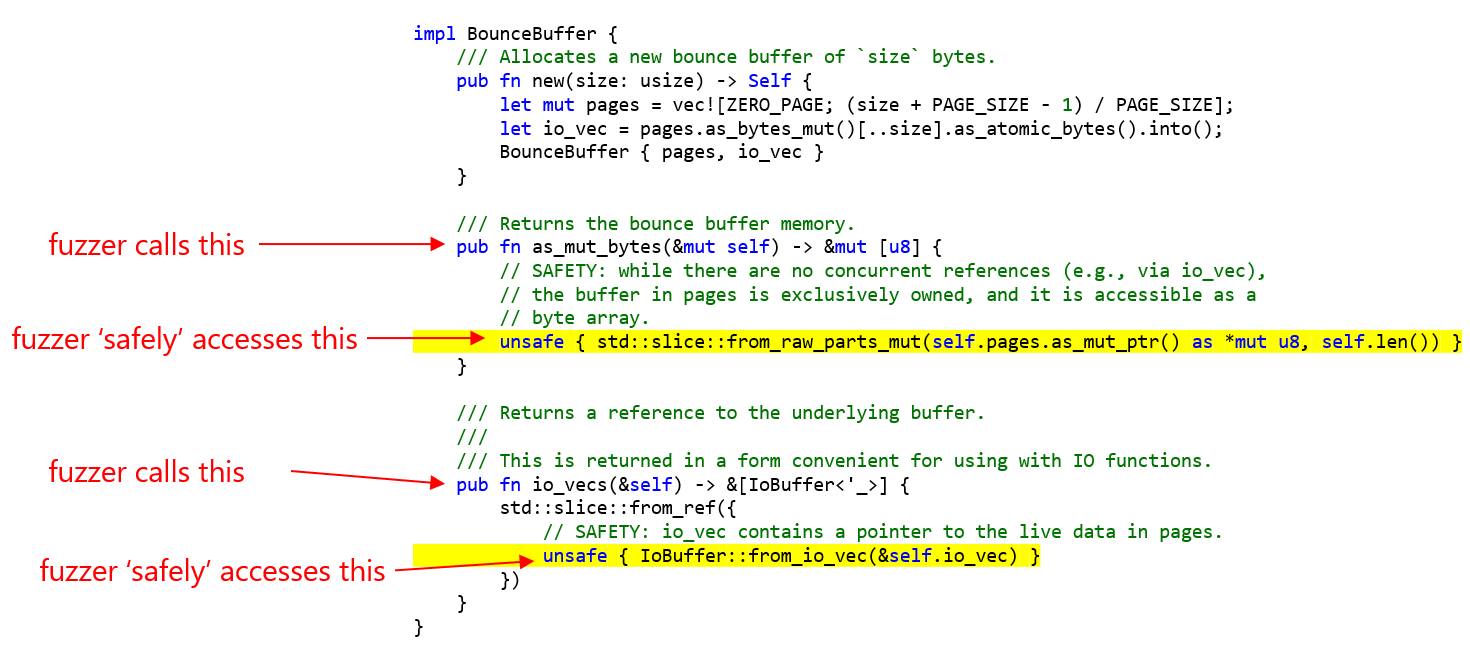Writing Fuzzers
Writing a new fuzzer in OpenVMM
The easiest way to get up and running is to look at the existing in-tree fuzzers
(which you can list using cargo xtask fuzz list), along with reading through
the cargo-fuzz book (the
book is fairly brief and shouldn't take more than 20 minutes to read through)
Some examples of in-tree fuzzers:
- Simple device example: chipset/fuzz/battery.rs
- More complex device example: ide/fuzz/fuzz_ide.rs
- Abstraction over unsafe example: ide/fuzz/fuzz_scsi_buffer.rs
Once you're ready to take a stab at writing your own fuzzer, spinning up a new fuzzer is as easy as running:
cargo xtask fuzz init openvmm_crate_to_fuzz TEMPLATE
Use --help for more details on the available TEMPLATE types.
We don't suggest using cargo fuzz init (i.e: without xtask), as it
emits a template that isn't compatible with the OpenVMM repo style, and also
doesn't properly update the root Cargo.toml's workspace.members array.
Fuzzing an abstraction over unsafe code
Unsafe code is a prioritized target for fuzzing given its self-evident risks.
However, it can be hard to reason about how best to exercise unsafe code in OpenVMM via fuzzing as often (and correctly) the unsafe code is not directly interacting with guest-controlled data.
The approach taken with OpenVMM then is to target abstractions over unsafe code.
Such as interfaces and data structures like BounceBuffers, guest_memory, or
ucs2. A fuzzer for one of these will attempt to be a regular consumer of the
abstraction, calling those APIs declared safe and using any data structure in a
rust-safe way. This attempts to check that the safety guarantees the abstraction
is making are being upheld via the API.
For example, let's say we want to fuzz BounceBuffers, here's what we may
want to fuzz:

Fuzz logic might then allocate a BounceBuffer using new and call methods on
it such as as_mut_bytes and io_vecs. Then it could access the return result
of both those calls:
use scsi_buffers::BounceBuffer;
#[derive(Arbitrary)]
enum BouneBufferAccess {
AsMutBytes,
IoVecs
}
#[derive(Arbitrary)]
struct FuzzCase {
#[arbitrary(with = |u: &mut Unstructured| u.int_in_range(0..=0x40000))]
size: usize,
accesses: Vec<BounceBufferAccess>
}
fn access_mut_bytes(buf: &mut [u8]) {
buf.fill(b'A');
// access buf in other ways to test validity of underlying memory and slice
}
fn access_io_vecs(io_vecs: &[IoBuffer]) {
// access each IoBuffer to test validity of ptr and len
}
fuzz_target!(|fuzz_case: FuzzCase| { do_fuzz(fuzz_case) });
fn do_fuzz(fuzz_case: FuzzCase) {
let mut bb = BounceBuffer::new(fuzz_case.size);
for access in fuzz_case.accesses {
match access {
AsMutBytes => {
let buf = bb.as_mut_bytes();
access_mut_bytes(buf);
},
IoVecs => {
let io_vecs = bb.io_vecs();
access_io_vecs(io_vecs)
}
}
}
}The fuzzer should work to ensure the safe members of the API cannot be misused in any way that may result in memory corruption or unsoundness.
Fuzzing a chipset device
Writing a fuzzer for a chipset device (e.g: battery, ide, serial, pic, etc...) involves targeting the API that is roughly exposed to guests: the device's port IO, PCI config, and MMIO interfaces.
While it's entirely possible to hand-roll a fuzzer that is tailored to the
specific register configuration of a particular device, the in-repo
chipset_device_fuzz crate exports a FuzzChipset type that offers a
"plug-and-play" way to hook a chipset device up to a fuzzer:
#[derive(Arbitrary)]
struct StaticDeviceConfig {
#[arbitrary(with = |u: &mut Unstructured| u.int_in_range(0..=16))]
num_queues: usize,
}
fn do_fuzz(u: &mut Unstructured<'_>) -> arbitrary::Result<()> {
// Step 1: generate a device's fixed-at-construction-time configuration
let static_device_config: StaticDeviceConfig = u.arbitrary()?;
// Step 2: init the device, and wire-it-up to the fuzz chipset
let mut chipset = chipset_device_fuzz::FuzzChipset::default();
let my_device = chipset.device_builder("my_dev").add(|services| {
my_dev::MyDevice::new(
static_device_config.num_queues,
&mut services.register_mmio(), // e.g: pci devices have BARs to remap their MMIO intercepts
)
}).unwrap();
// Step 3: use the remaining fuzzing input to slam the device with chipset events
while !u.is_empty() {
let action = chipset.get_arbitrary_action(u)?;
xtask_fuzz::fuzz_eprintln!("{:x?}", action); // only prints when running a repro
chipset.exec_action(action).unwrap();
// Step 3.5: (optionally) intersperse "external stimuli" between chipset actions
if u.ratio(1, 10)? {
let event: u32 = u.arbitrary()?;
my_device.report_external_event(event);
}
}
Ok(())
}
fuzz_target!(|input: &[u8]| -> libfuzzer_sys::Corpus {
if do_fuzz(&mut Unstructured::new(input)).is_err() {
libfuzzer_sys::Corpus::Reject
} else {
libfuzzer_sys::Corpus::Keep
}
});Fuzzing a vmbus device
TBD (no such fuzzers exist in-tree today)
Fuzzing async code
Depending on the nature of the 'async' code in question, there are two main recommended approaches to fuzzing it:
-
now_or_never: The recommended approach for individual asynchronous calls is to use the
now_or_nevermethod from thefuturescrate. This method will poll the future to completion, but will not block if the future is not ready to complete. This allows you to fuzz the future without needing to run it to completion, which can be useful for testing the behavior of the future in various states. -
DefaultPool::run_with: The recommended approach for more intricate asynchronous requirements is to use the
DefaultPool::run_withmethod from ourpal_asynccrate. This method takes a custom async function and runs it to completion. This allows you to write custom code using regular async/await syntax, combinators,joins,selects, or whatever you wish.